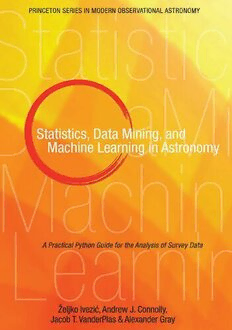Table Of ContentStatistics, Data Mining, and
Machine Learning in Astronomy
PRINCETON SERIES IN MODERN OBSERVATIONAL ASTRONOMY
DavidN.Spergel,SERIES EDITOR
Written by some of the world’s leading astronomers, the Princeton Series in Modern
ObservationalAstronomyaddressestheneedsandinterestsofcurrentandfutureprofes-
sional astronomers. International in scope, the series includes cutting-edge monographs
andtextbooksontopicsgenerallyfallingunderthecategoriesofwavelength,observational
techniques and instrumentation, and observational objects from a multiwavelength
perspective.
Statistics, Data Mining, and
Machine Learning in Astronomy
A PRACTICAL PYTHON GUIDE FOR THE ANALYSIS OF SURVEY DATA
Željko Ivezic´, Andrew J. Connolly,
Jacob T. VanderPlas, and Alexander Gray
•
PRINCETON UNIVERSITY PRESS PRINCETON AND OXFORD
Copyright©2014byPrincetonUniversityPress
PublishedbyPrincetonUniversityPress,41WilliamStreet,
Princeton,NewJersey08540
IntheUnitedKingdom:PrincetonUniversityPress,6OxfordStreet,
Woodstock,OxfordshireOX201TW
press.princeton.edu
AllRightsReserved
ISBN978-0-691-15168-7
LibraryofCongressControlNumber:2013951369
BritishLibraryCataloging-in-PublicationDataisavailable
ThisbookhasbeencomposedinMinionProw/Universelightcondensedfordisplay
Printedonacid-freepaper∞
TypesetbySRNovaPvtLtd,Bangalore,India
PrintedintheUnitedStatesofAmerica
10 9 8 7 6 5 4 3 2 1
Contents
Preface vii
I Introduction
1
1 AbouttheBookandSupportingMaterial 3
1.1 WhatDoDataMining,MachineLearning,andKnowledgeDiscovery
Mean? 3
1.2 WhatisThisBookAbout? 5
1.3 AnIncompleteSurveyoftheRelevantLiterature 8
1.4 IntroductiontothePythonLanguageandtheGitCodeManagement
Tool 12
1.5 DescriptionofSurveysandDataSetsUsedinExamples 14
1.6 PlottingandVisualizingtheDatainThisBook 31
1.7 HowtoEfficientlyUseThisBook 37
References 39
2 FastComputationonMassiveDataSets 43
2.1 DataTypesandDataManagementSystems 43
2.2 AnalysisofAlgorithmicEfficiency 44
2.3 SevenTypesofComputationalProblem 46
2.4 SevenStrategiesforSpeedingThingsUp 47
2.5 CaseStudies:SpeedupStrategiesinPractice 50
References 63
II Statistical Frameworks and Exploratory Data Analysis
67
3 ProbabilityandStatisticalDistributions 69
3.1 BriefOverviewofProbabilityandRandomVariables 70
3.2 DescriptiveStatistics 78
3.3 CommonUnivariateDistributionFunctions 85
3.4 TheCentralLimitTheorem 105
3.5 BivariateandMultivariateDistributionFunctions 108
3.6 CorrelationCoefficients 115
3.7 RandomNumberGenerationforArbitraryDistributions 118
References 122
vi (cid:127) Contents
4 ClassicalStatisticalInference 123
4.1 Classicalvs.BayesianStatisticalInference 123
4.2 MaximumLikelihoodEstimation(MLE) 124
4.3 ThegoodnessofFitandModelSelection 131
4.4 MLAppliedtoGaussianMixtures:TheExpectationMaximization
Algorithm 134
4.5 ConfidenceEstimates:theBootstrapandtheJackknife 140
4.6 HypothesisTesting 144
4.7 ComparisonofDistributions 149
4.8 NonparametricModelingandHistograms 163
4.9 SelectionEffectsandLuminosityFunctionEstimation 166
4.10 Summary 172
References 172
5 BayesianStatisticalInference 175
5.1 IntroductiontotheBayesianMethod 176
5.2 BayesianPriors 180
5.3 BayesianParameterUncertaintyQuantification 185
5.4 BayesianModelSelection 186
5.5 NonuniformPriors:Eddington,Malmquist,andLutz–KelkerBiases 191
5.6 SimpleExamplesofBayesianAnalysis:ParameterEstimation 196
5.7 SimpleExamplesofBayesianAnalysis:ModelSelection 223
5.8 NumericalMethodsforComplexProblems(MCMC) 229
5.9 SummaryofProsandConsforClassicalandBayesianmethods 239
References 243
III Data Mining and Machine Learning
247
6 SearchingforStructureinPointData 249
6.1 NonparametricDensityEstimation 250
6.2 Nearest-NeighborDensityEstimation 257
6.3 ParametricDensityEstimation 259
6.4 FindingClustersinData 270
6.5 CorrelationFunctions 277
6.6 WhichDensityEstimationandClusteringAlgorithmsShouldIUse? 281
References 285
7 DimensionalityandItsReduction 289
7.1 TheCurseofDimensionality 289
7.2 TheDataSetsUsedinThisChapter 291
7.3 PrincipalComponentAnalysis 292
7.4 NonnegativeMatrixFactorization 305
7.5 ManifoldLearning 306
7.6 IndependentComponentAnalysisandProjectionPursuit 313
7.7 WhichDimensionalityReductionTechniqueShouldIUse? 316
References 318
Contents (cid:127) vii
8 RegressionandModelFitting 321
8.1 FormulationoftheRegressionProblem 321
8.2 RegressionforLinearModels 325
8.3 RegularizationandPenalizingtheLikelihood 332
8.4 PrincipalComponentRegression 337
8.5 KernelRegression 338
8.6 LocallyLinearRegression 339
8.7 NonlinearRegression 340
8.8 UncertaintiesintheData 342
8.9 RegressionthatisRobusttoOutliers 344
8.10 GaussianProcessRegression 349
8.11 Overfitting,Underfitting,andCross-Validation 352
8.12 WhichRegressionMethodShouldIUse? 361
References 363
9 Classification 365
9.1 DataSetsUsedinThisChapter 365
9.2 AssigningCategories:Classification 366
9.3 GenerativeClassification 368
9.4 K-Nearest-NeighborClassifier 378
9.5 DiscriminativeClassification 380
9.6 SupportVectorMachines 382
9.7 DecisionTrees 386
9.8 EvaluatingClassifiers:ROCCurves 394
9.9 WhichClassifierShouldIUse? 397
References 400
10 TimeSeriesAnalysis 403
10.1 MainConceptsforTimeSeriesAnalysis 404
10.2 ModelingToolkitforTimeSeriesAnalysis 405
10.3 AnalysisofPeriodicTimeSeries 426
10.4 TemporallyLocalizedSignals 452
10.5 AnalysisofStochasticProcesses 455
10.6 WhichMethodShouldIUseforTimeSeriesAnalysis? 465
References 465
IV Appendices
469
A AnIntroductiontoScientificComputingwithPython 471
A.1 ABriefHistoryofPython 471
A.2 TheSciPyUniverse 472
A.3 GettingStartedwithPython 474
A.4 IPython:TheBasicsofInteractiveComputing 486
A.5 IntroductiontoNumPy 488
A.6 VisualizationwithMatplotlib 494
A.7 OverviewofUsefulNumPy/SciPyModules 498
viii (cid:127) Contents
A.8 EfficientCodingwithPythonandNumPy 503
A.9 WrappingExistingCodeinPython 506
A.10OtherResources 508
B AstroML:MachineLearningforAstronomy 511
B.1 Introduction 511
B.2 Dependencies 511
B.3 ToolsIncludedinAstroMLv0.1 512
C AstronomicalFluxMeasurementsandMagnitudes 515
C.1 TheDefinitionoftheSpecificFlux 515
C.2 WavelengthWindowFunctionforAstronomicalMeasurements 515
C.3 TheAstronomicalMagnitudeSystems 516
D SQLQueryforDownloadingSDSSData 519
E ApproximatingtheFourierTransformwiththeFFT 521
References 525
VisualFigureIndex 527
Index 533
Preface
Astronomy and astrophysics are witnessing dramatic increases in data volume as
detectors, telescopes, and computers become ever more powerful. During the last
decade, sky surveys across the electromagnetic spectrum have collected hundreds of
terabytesofastronomicaldataforhundredsofmillionsofsources.Overthenextdecade,
data volumes will enter the petabyte domain, and provide accurate measurements for
billions of sources. Astronomy and physics students are not traditionally trained to
handlesuchvoluminousandcomplexdatasets.Furthermore,standardanalysismethods
employedinastronomyoftenlagfarbehindtherapidprogressinstatisticsandcomputer
science.Themainpurposeofthisbookistohelpminimizethetimeittakesastudentto
becomeaneffectiveresearcher.
This book provides the interface between astronomical data analysis problems and
modernstatisticalmethods.Itisaimedatphysicalanddata-centricscientistswhohavean
understandingofthesciencedriversforanalyzinglargedatasetsbutmaynotbeawareof
developments in statistical techniques over the last decade. The book targets researchers
who want to use existing methods for the analysis of large data sets, rather than those
interestedinthedevelopmentofnewmethods.Theoreticaldiscussionsarelimitedtothe
minimum required to understand the algorithms. Nevertheless, extensive and detailed
referencestorelevantspecialistliteratureareinterspersedthroughoutthebook.
We present an example-driven compendium of modern statistical and data mining
methods,togetherwithcarefullychosenexamplesbasedonrealmoderndatasets,andof
currentastronomicalapplicationsthatwillillustrateeachmethodintroducedinthebook.
The book is loosely organized by practical analysis problems, and offers a comparative
analysisofdifferenttechniques,includingdiscussionsoftheadvantagesandshortcomings
of each method, and their scaling with the sample size. The exposition of the material is
supportedbyappropriatepubliclyavailablePythoncode(availablefromthebookwebsite,
ratherthanfullyprintedhere)anddatatoenableareadertoreproduceallthefiguresand
examples,evaluatethetechniques,andadaptthemtotheirownfieldofinterest.Tosome
extent,thisbookisananalogofthewell-knownNumericalRecipesbook,butaimedatthe
analysisofmassiveastronomicaldatasets,withmoreemphasisonmoderntoolsfordata
miningandmachinelearning,andwithfreelyavailablecode.
From the start, we desired to create a book which, in the spirit of reproducible
research, would allow readers to easily replicate the analysis behind every example and
figure. We believe thisfeaturewillmakethe bookuniquelyvaluable asapracticalguide.
WechosetoimplementthisusingPython,apowerfulandflexibleprogramminglanguage
that is quickly becoming a standard in astronomy (a number of next-generation large
astronomicalsurveysandprojectsusePython,e.g.,JVLA,ALMA,LSST).ThePythoncode
base associated with this book, called AstroML, is maintained as a live web repository
(GitHub),andisintendedtobeagrowingcollectionofwell-documentedandwell-tested
toolsforastronomicalresearch.Anyastronomicalresearcherwhoiscurrentlydeveloping

